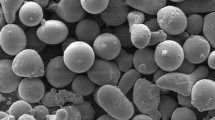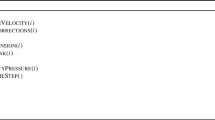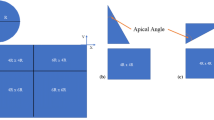Abstract
Thermal spray coatings have porosity; however, reasons for the production of porosity during the coating process are not known. This paper proposes a physical and mathematical model for the production of porosity by considering deformation of a molten particle during thermal spray coating processes. The theoretical model shows that the impinging velocity, the ambient gas pressure, the particle diameter, and the molten material viscosity contribute to producing porosity. This paper also proposes that there is a porosity distribution along the splat radius and that most of the porosity exists in the periphery of the splat. Also, a flattening model proposed in this work agrees well with the results of Engel (Ref 1).
Similar content being viewed by others
References
O.G. Engel, Waterdrop Collisions With Solid Surfaces,J. Res. Nat. Bur. Stand., Vol 54 (No. 5), May 1955, p 281–298
R. McPherson, The Relationship Between the Mechanism of Formation, Microstructure, and Properties of Plasma Sprayed Coatings,Thin Solid Films, Vol 83,1981, p 297–310
R. McPherson and B.V. Shafer, Interlamellar Contact Within Plasma-Sprayed Coatings,Thin Solid Films, Vol 97,1982, p 201–204
S. Safai and H. Herman, Microstructural Investigaon of Plasma-Sprayed Coatings,Thin Solid Films, Vol 45,1977, p 295–307
Y. Arata, A. Ohmori, and C. Li, Electrochemical Method to Evaluate the Connected Porosity in Ceramic Coatings,Thin Solid Films, Vol 156,1988, p 315–325
Y. Arata, A. Ohmori, and C. Li, Study on the Structure of Plasma Sprayed Ceramic Coating by Using Copper Electroplating,Proc. ATTC (Osaka, Japan), May 1988, p 205–210
H. Jones, Cooling, Freezing and Substrate Impact of Droplets Formed by Rotary Atomization,J. Appl. Phys., Vol 4,1971, p 1657–1660
J. Madejski, Solidification Droplets on a Cold Surface,Int. J. Heat Transfer, Vol 19, 1976, p 1009–1013
H.S. Carlow and J.C. Jaeger,Conduction of Heat in Solids, 2nd ed.,Oxford University Press, Oxford, England, 1959, p 285
H. Fukanuma, An Analysis of the Porosity Producing Mechanism,Thermal Spray: International Advances in Coatings Technology, C.C. Berndt, Ed., ASM International, 1992, p 767–772
N. Rajaratnam, Chapter 11,Turbulent Jets, Elsevier Scientific Publishing Co., 1981 (translated to Japanese)
M. Poreh and J.E. Cermark, Flow Characteristics of a Circular Submerged Jet Impinging Normally on a Smooth Boundary,Proc. Sixth Mid-Western Conf. on Fluid Mechanics, 1967, p 198–212
S. Beltaos and N. Rajaratnam, Impinging Circular Turbulent Jet, Proc.A.S.C.E. J. Hydraulics Division, 1974, p 1313–1328
L.D. Landau and E.M. Lifshitz,Fluid Mechanics, 2nd ed., Pergamon Press, Oxford, England, 1987, p 50–51
Author information
Authors and Affiliations
Rights and permissions
About this article
Cite this article
Fukanuma, H. A porosity formation and flattening model of an impinging molten particle in thermal spray coatings. JTST 3, 33–44 (1994). https://doi.org/10.1007/BF02648997
Issue Date:
DOI: https://doi.org/10.1007/BF02648997




